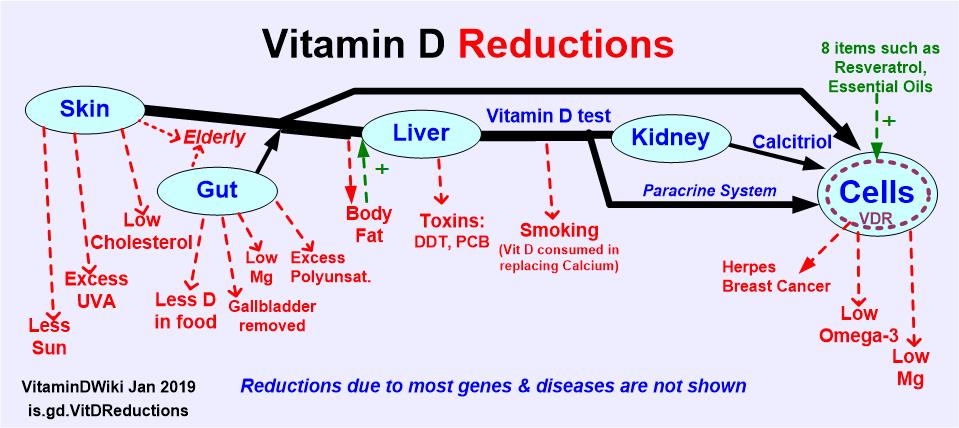Simple Vitamin D deficiency scoring system
Quick and Easy Screening for Vitamin D Insufficiency in Adults: A Scoring System to Be Implemented in Daily Clinical Practice.
Medicine (Baltimore). 2016 Feb;95(7):e2783. doi: 10.1097/MD.0000000000002783.
Deschasaux M1, Souberbielle JC, Andreeva VA, Sutton A, Charnaux N, Kesse-Guyot E, Latino-Martel P, Druesne-Pecollo N, Szabo de Edelenyi F, Galan P, Hercberg S, Ezzedine K, Touvier M.
1From the Sorbonne Paris Cité Epidemiology and Statistics Research Center (CRESS) (MD, VAA, EK-G, PL-M, ND-P, FSdE, PG, SH, KE, MT), Nutritional Epidemiology Research Team (EREN), Inserm U1153, Inra U1125, Cnam, Paris 13 University, Bobigny; Department of Physiology (J-CS), Necker Hospital, Inserm U845, Paris; Jean Verdier Hospital, Biochemistry Department (AS, NC), Inserm U698, Paris 13 University, Bondy; Public Health Department (SH), Avicenne Hospital, Bobigny; and Dermatology Department (KE), Henri Mondor Hospital, Paris, France.
moderate sun exposure, very fair or dark skin | | 2 | latitude ≥48°N and spring season | | 2.5 | obesity and late winter | | 3 | low sun exposure | | | | | --- | --- | | Total points | < 20 ng | | 7 | 70% | | >9 | 80% | Their simple system does not consider the following Low magnesium, smoking, cola drinks, low cholesterol in diet health problems which consume Vitamin D Excessive UVA (thru windows, late afternoont) Poor gut, DDT, Excessive Vitamin A, Gall bladder removed Take drug which consumes of blocks Vitamin D Age - reduced vitamin D from gut and from skin, reduced stomach acid Pregnancy, Excessive clothing, Poor Kidney. Low Omega-3 Roundup in food, Night shift. Born in winter. Genes See VitaminDWiki * Is 50 ng of vitamin D too high, just right, or not enough * Predict Vitamin D **category listing has items along with related searches** * Model has 80 percent chance of predicting vitamin D levels to within 10 ng – Feb 2012 * Toward predicting vitamin D levels without a blood test. * Higher air pollution associated with 7 ng lower vitamin D levels – Aug 2013 * Free Vitamin D evaluation service * Molecular Approaches for Optimizing Vitamin D (one size does not fit all) – Carlberg Nov 2015 * 43 reasons for Vitamin D deficiency * Vitamin D Deficiency * Reasons for low response to vitamin D which has the following

📄 Download the PDF from VitaminDWiki


Vitamin D is essential regarding several health outcomes. Prevention of insufficiency (25-hydroxyvitamin D concentration ≤20 ng/mL) generally entails blood testing and/or supplementation, strategies that should target at-risk individuals because blood testing is costly, and unwarranted supplementation could result in vitamin D overload with unknown long-term consequences.Our objective was to develop a simple score (Vitamin D Insufficiency Prediction score, VDIP) for identifying adults at risk of vitamin D insufficiency.Subjects were 1557 non-vitamin D-supplemented middle-aged adults from the SU.VI.MAX cohort. Scoring points corresponded to the rounded odds ratio for each individual-level characteristic associated with vitamin D insufficiency in a multivariable logistic regression model. Receiver operating characteristic curve (area under curve), sensitivity, specificity, and positive and negative predictive values were computed. External validation was performed in an independent cohort (NutriNet-Santé, N = 781).For female sex, overweight, low physical activity, winter season, moderate sun exposure, and very fair or dark skin 1.5 points were attributed; 2 points for latitude ≥48°N and spring season; 2.5 points for obesity and late winter; 3 points for low sun exposure. Points were then summed up for each participant. The VDIP score had an AUC = 0.70 ± 0.01 (validation: 0.67 ± 0.02). With a score of 7 or more, 70% of the participants were vitamin D-insufficient (80% in those with a score ≥9), sensitivity/specificity were 0.67/0.63, and positive and negative predictive values were 0.70/0.59. The VDIP score performed well in identifying middle-aged adults at risk of vitamin D insufficiency (score ≥7, moderate risk; score≥9, high risk), using only simple individual-level characteristics easily assessable in day-to-day clinical practice. Implementation of this simple and costless score could thus obviate unwarranted supplementation and/or blood testing.
PMID: 26886626
